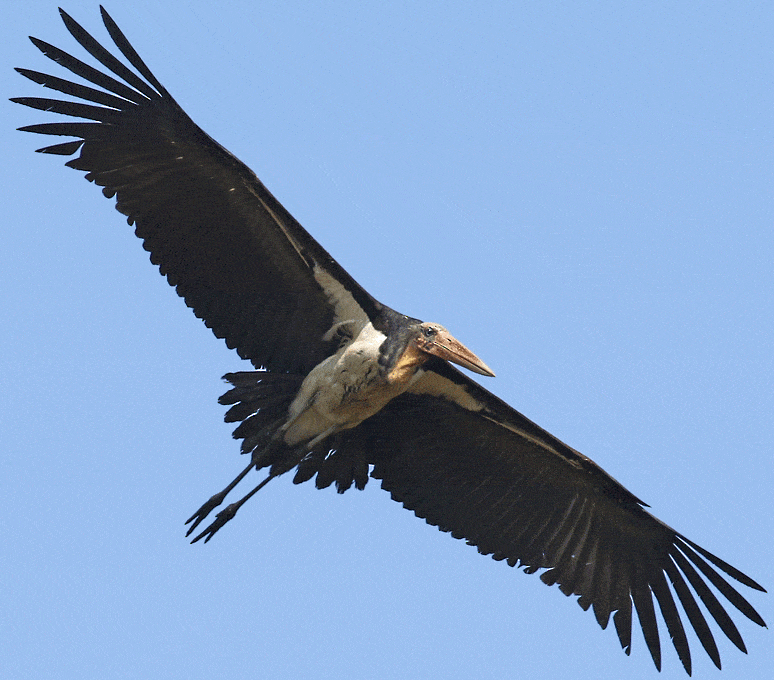By Dr Lucy Mathen
‘The Adjutant half turned his head, sheered a little in the direction of the voice, and landed stiffly on the sand-bar below the bridge. Then you saw what a ruffianly brute he really was. His back view was immensely respectable, for he stood nearly six feet high, and looked rather like a very proper bald-headed parson. In front it was different, for his head and neck had not a feather to them…His legs were long and thin and skinny, but he moved them delicately, and looked, at them with pride as he preened down his ashy-grey tail-feathers, glanced over the smooth of his shoulder, and stiffened into ‘Stand at attention.’ – The second Jungle Book, Rudyard Kipling.

Kipling is describing a Greater Adjutant and what we saw, en route to a village screening camp in rural north India, was a bird with which it is often mistaken, the Lesser Adjutant. Our sighted bird had a punk tuft of feathers on its otherwise bald head and its bill was narrower than the wedge-shaped yellowed version of the greater adjutant. Nor did it have the characteristic pendulous pouch of that bird. First impressions of both birds, however, are the same. Sheer breath-taking size. That’s what caused our collective gasp of awe and the hospital driver to slow down our vehicle.
I have been running the small sight charity Second Sight for 24 years now. We work exclusively in the Indian state of Bihar – a region with over 100 million of the poorest people in India, but rich in wildlife including birds. So, I have always refused to appeal for funds (as other charities do) by presenting our patients as victims who, once given second sight after cataract surgery can work, earn a living and not be a burden on their impoverished families. Instead I say: “…imagine being able to enjoy once more the iridescent flash of a kingfisher flying low over a river.”
And now, finally, we have a way for potential funders to visit Bihar and appreciate the combined wonders of ophthalmology and ornithology. I will explain. But first let me just catalogue some of the birds that we saw on our most recent trip in January 2024.
- A couple of Hoopoes pecking the ground outside the walls of Bamdah Mission Hospital in Jamui district, southern Bihar. I love to think that this species has been here for the 130 years that this hospital has been providing eye services to the poor. (The Common Hornbills that local eye surgeon Dr Samuel Murmu and I used to watch as they gathered in the spreading fruit tree in his garden, suddenly disappeared around 10 years ago.)
- Also in Jamui, Black Ibis who have deserted the tall palm trees, their previous gathering point, in favour of an ugly telephone mast. Each evening they vie with noisy green parrots in a cacophony of birdcalls.
- A Golden Oriole in Madhepura district, north-eastern Bihar, which caught our eye as we left the home of local ophthalmologist Dr Amit Anand.
- A Common Kingfisher executing a rather attention-seeking circular flight for us as we walked past it en route to the Anand Eye Hospital. Many others elsewhere.
- A Pied Kingfisher spotted by one of our group.
- Indian Rollers galore (often confused with kingfishers)
- Egrets
- Koels
- Mynas including Pied Mynas
- And finally that awesome Lesser Adjutant who later flew so low over us we could make out the head hunkered into the neck, its huge wingspan, long legs and feet pointed like a ballet dancer. It chose the moment when we had identified a patient who, very sadly, was irreversibly blind in one eye, her injury to the cornea treated inappropriately by a quack doctor. Reminding us all of the importance of our work.
So how can you birders of the world help? Well, in the Bihar district of Madhepura, there is now an Eco Hotel. It is powered by solar energy, serves food grown locally, and encourages the protection of the environment and the promotion of good health – there is a lift for disabled guests but others are urged to take stairs. The hotel is above the Anand Eye Hospital. Both are the brainchildren of ophthalmologist Dr Amit Anand. He would like income from the hotel to help fund vital surgery for cataract-blind patients who are simply too poor to pay. As you come and go on your birding trips (planned using the routes taken by the village screening teams) you can step through glass doors on the ground floor and watch the busy community eye hospital at work.
This article has probably taken you about 3 minutes to read. That’s about the time it takes Dr Amit to perform a cataract operation… for about the same cost as a night’s accommodation at the Hotel Ananda, about £20.
How to get there: Flight to Delhi – Flight or train to Patna in Bihar – Train to Madhepura (telegraph-pole birdwatching all the way) – Vehicle to the Hotel Ananda. Contact: hotelananda79@gmail.com Tel : + 919798536178/ +919234247822
